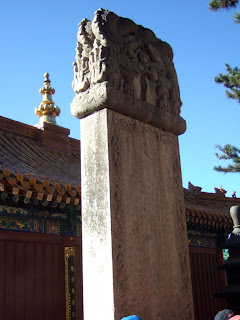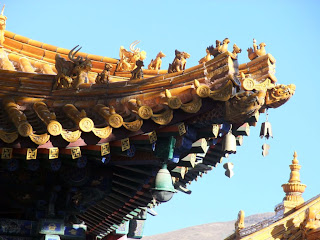
The Monastery of Pusa-Ding (菩萨顶) sitting at the highest point of Central Terrace at the peak of Lingjiu-feng (灵鹫峰), in north-west of Town Taihuai-zhen (台怀镇), looks like another Potala-Gong Monastery of Tibet from distance. It is the largest and most complete Tibetan Monastery in Wutaishan. The Temple was called The Great Monastery of Manjushri (大文殊院) when it was first established in Northern Wei Dynasty during the reign of Emperor Xiaowen-Di (孝文帝 671-499 BC). After the restoration in year 631 during Tang Dynasty (618-907 AD) by a monk named Rev. Fayun (法云法师), it changed the name to Zhenrong-Yan (真容院). The temple site was expanded and to enshrine with an image of Manjushri by an imperial order in year 1004 during Song Dynasty. A plague written with Fengzhen-Ge (奉真阁) was then presented by the Emperor. In Ming Dynasty Zhenrong-yuan was ordered to rebuilt into The Great Temple of Manjushri (大文殊寺) within years 1403-1425 and the name was continued using until today. The monastery was now commonly known as Pusa-Ding which literally means the summit of Bodhisattva.



The most glorious period of the Monastery was during Qing Dynasty (1644-1911)when it was converted into a Lamasery by Emperor Shunzhi (顺治帝) in year 1656. In order to further gained the faith from Tibetan and Mongolian, Emperor Kangxi (1662-1722) bestowed The Title of Provincial Commander-in-Chief to the Monastery Senior Lama and ordered the whole state of Shanxi to allocate contribution to the temple. The roofing tiles of the Monastery were also changed to royal yellow glazed tiles in years 1683-1691, as used for those imperial buildings. All Lama temples were then under the control of Pusa-Ding as The Imperial authority had made it in the highest leading position of the region. The site had been the accommodation lodge for Qing Emperors, Mongolian Warlords, Tibetan Lama whenever they traveled to Wutaishan for pilgrimage.



The 108 steps were made up of whole piece of stone and they are like layers of stone plastered towards the sky, steep and precipitous. The colorful Gateway on the platform above the top of 108 stone steps was said to be erected by Emperor Kangxi of Qing Dynasty when he visited Wutaishan in year 1714. It was supported by 4 pillars and has three layers on top with three entrances. The four Chinese characters 灵峰仙境 (meaning the fairy site at Lingjiu Peak)inscribed at the central was written by The Emperor. When we stand below the Gateway, the enclosed scenic sights and the magnificent undulating view of the close and distance mountainous region are under our bird eye view.



A short distance of the stone steps that connected to the entrance gate has an imperial pathway in the center. The sloping portion was beautifully carved with the sucking water nine entangled dragons. Their turning and rolling expression were almost closed to reality.


The well taken care complex occupies a total land area of 45 acres with 430 building structures at the site. The vast internal area is basically flat. Lokapala Hall, Sakyamuni Hall and Bodhisattva Hall are the three main building structures at site.



At the center court, there is a huge board inscribed with mantra Dabei-zhou and a Dragon Stele embossed with several pairs of dragons guarding the pearls.



The Main Shrine Hall is the venue for all large activities held at site. The Hall enshrines Three Buddha Images of Sakyamuni, Amitaba and Maitreya, representing Buddha of the Past, the Present and The Future. Many Tibetan Dalai Lama and Panchan Lama in the past had given Dharma talk at this Hall.



Pusa-Ding contains many Steles and boards that were inscribed with message characters written by various emperors who had pay visit to the site.



The four surfaces of the two 6 meter high marble pillar Stele at east court and back yard were engraved in four languages: Tibetan, Mongolian, Manchurian and Mandarin. The poem styled compliments on it was hand written by Emperor Qianlong of Qing Dynasty.



The classic roof that were covered with royal imperial yellow glazed tiles.



I love those animal figurines at the roof eave.


The Vajra Hall.



Lokapala Hall is at the first court of the site.


Who is she? The One footed faceless woman at Pusa-Ding. This is the delights of Wutaishan. It attracts variety of people in different orders from China, Nepal, Japan, Thailand. They are monks, nuns, lamas and lay people.



Manjushri Hall with yellow glazed tiles though was rebuilt few hundreds years ago in Qing Dynasty, it looks recent and new. The colored clay image of Bodhisattva Manjushri was enshrined at the Altar with 18 Arahat sculptures by two sides.


.jpg)
The front yard of Manjushri Hall also has some Stele and inlaid at the cross beam of the stone wall was four Chinese character 五台圣境 which means the sacred site of Wutaishan. It was the hand writing of Emperor Kangxi.



Hall of Manjushri is also known as Water Dripping Hall (滴水殿) as water was found dripping down from roofing eave for a long period and had caused stalagmite at the stone steps under it. Leaving a hole at the roofing tiles to receive water in the raining season and stored at the leak-proof underneath area, was actual a special architectural design of the ancient construction. Stalagmite was gradually formed when water slowly seeped out from the storage area during non-raining months and dropped from the roof eave onto the ground. Currently there was no more water dropping down from the eave as people who did the restoration work did not know how to reserve it.



Manjushri Hall is an essential structure one should not missed when visit Pusa-Ding.



The golden glaring yellow roof of Manjushri Hall and its awesome metal caldron.


Daguo Yard (大锅院) was at the back yard of the Monastery and an image of Boddhisattva Earth-stored Dizang was enshrined inside the hall.


The ceiling of the structure where the large olden woks were placed were supported by some cross beams made from wood log with beautiful colored vein.


The huge woks placed at the back yard were very famous in Wutaishan. The big one measured at 2.04 meter in diameter with depth 1.15 meter and even the smaller one also has a diameter of 1.33 meter. In the past, these woks were used twice in a year. The prior purpose was to cook rice and steam white faced demon king bun for the Lama from Yellow Sect Temples who gathered here to perform activities in the suppress demons festival in 6th Lunar month each year. Another time was to boil the 8-treasures porridge (Rice + soya beans + mung beans + lotus seed + chestnut + dates + walnut + red sugar) in the enlightened day of Buddha on 8th day of 12th lunar month.


Some old structures at back yard of Pusa-Ding especially the pair of ancient stone blocks of the door which can hardly been seen nowadays. The stone carved arch door at Dacheng-men (大乘门) is fabulous.



Being a symbol of emperor, this golden illustration of 5 claws dragon looks vivid and lively. The large Chinese word 福 (pronouns as fu)which means blessing, was another hand writing of Emperor Kangxi.



The best time to visit Pusa-Ding is July as Lamasery serves as the main venue for the annual congregation of the Yellow Hat Sect of Tibetan Buddhism in this month. Commencing from 4th to 15th of 6th lunar month, there are many activities and festive ceremonies that were inherited down from the past. On the 14th day, The Lama wear different masks and costumes, chanting the sutra to suppress the demons with Vajra dances. The festival usually ended in an extravagant carnival celebration and possession on the streets with dances, drum and gong.



The interesting legend of Pusa-Ding was relating to Emperor Kangxi (1662-1722) of Qing Dynasty. It was said that when he once visited Wutaishan and stayed in Xiantong-si Monastery, the Abbot gladly informed him about a good sign that two water source wells were discovered at the main hall of Entrance Gate at Pusa-Ding. The Emperor listened but gave no response. After few days of wondering at town area, he one day suddenly ordered to place two of his written stone stele over the two newly found spring wells. The monks had no alternative but to follow the imperial order and seal up the wells forever. The officials confused at the Emperor's decision and asked for the reason one day when he was happy in the palace. The Emperor revealed the cause that when he looked back at Pusa-Ding from the town that day , he saw there were two huge pine trees by two sides of the Entrance Gate as if a pair of dragon horns and the temple itself appeared exactly like a dragon head. The two newly found spring wells served as the dragon's eyes, putting the dragon in a take off position. It was believed that if there was a dragon symbol in ready to fly posture, the place would deliver a future emperor. Qing Emperors were Manchurian who just defeated Han and conquered China. Kangxi was afraid that Wutaishan might produce a future Han Emperor and took back his Kingdom. He covered up the two spring wells to destroy a dragon symbol.



View across the buildings and over see the ridges and ranges rising high up beyond from the top at the back of Pusa-Ding.



Snow capped Central Terrace.


It was a blessing that we were exempted in climbing up the 108 steep stone steps in Pusa-Ding as the bus which we had wrongly hopped in drove us up to the top and dropped us off at the back yard. The green bus was actually being hired privately by a group of tourists from Canton. Without knowing about this, we jumped into the bus as invited by the driver who perhaps might mistook us as one of the member. We visited Pusa-Ding in a private vehicle with a private tourist guide. Appreciate so much for the kind arrangement of Bodhisattva Manjushri.



Thankyou for your blog. I first visited China in 2000 and Wutaishan was the last destination on my trip. I didn't have a digital camera then so I only took a few photos. It is wonderful to see all your photos and much detail in your description. Thankyou very much. It has helped me enjoy the wonderful memory of my visit there so much. Great work on your blog!
ReplyDelete